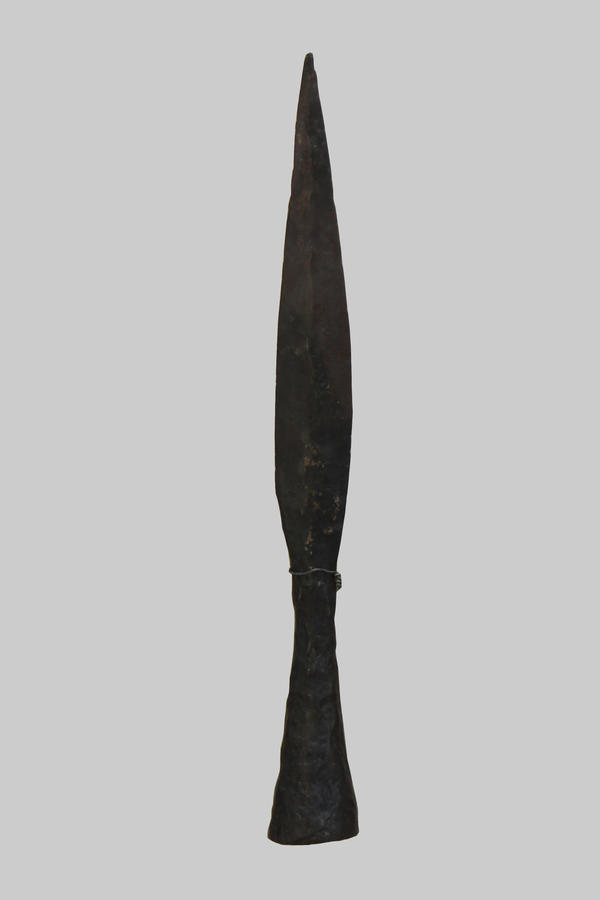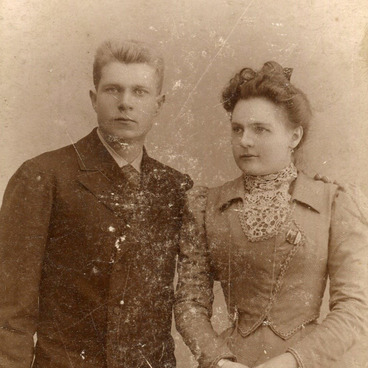The spearhead of an iron spear was found during the excavations of Mordovian - Parks burial site in 2007. Research works were taken place near Mordovian Parks village which is in Krasnoslobodsk District of the Republic of Mordovia. The artefact was given to the museum by Victor Vikhlyaev, a professor, Doctor of History.
The spear is a pointing, throwing or pointing-throwing cold weapon which was used by ancient warriors for defence and attack. Spears could be used in both close-in and long-range combats. The presence of a squad of spearmen which appeared in the 11th century let the army fight in proper tactical dispositions. Already by the middle of the 15th century rather well-structured system of conducting a battle by cavalrymen and infantrymen had been formed. Besides, the number of the army was counted according to the number of spears. For a long time, ‘spears’ were used to signify senior retainers with their detachments.
Darts-sulitsa were additional means of striking in a battle or on hunt. These are throwing darts with an iron tip of about 15-20 cm and a shaft from 1,2 to 1,5 metre long. As a rule, the edge of sulitsa had an elongate triangular shape, but during the archaeological excavations there were found spearheads in the shape of a bay leaf or a rhombus. They were compact and comfortable, ideally suited for being used on a rough terrain, in hand-to -hand clash and in a pursuit, that’s why in mature and late Middle Ages the popularity of such spears significantly increased.
Darts and spears can be met in burial sites of the 10th-13th centuries, which were found on the territory of Northern Russia. Thus, there was proved a fact, that throwing and pointing weapons of various shapes and sizes belonged to the widespread type of weapon. More often spears with lanceolate spearheads are found in burial sites of Russian warriors. The standard length of such a weapon was equal to the man’s height, but the length of spears and pikes reach 3 meters.
The spear is a pointing, throwing or pointing-throwing cold weapon which was used by ancient warriors for defence and attack. Spears could be used in both close-in and long-range combats. The presence of a squad of spearmen which appeared in the 11th century let the army fight in proper tactical dispositions. Already by the middle of the 15th century rather well-structured system of conducting a battle by cavalrymen and infantrymen had been formed. Besides, the number of the army was counted according to the number of spears. For a long time, ‘spears’ were used to signify senior retainers with their detachments.
Darts-sulitsa were additional means of striking in a battle or on hunt. These are throwing darts with an iron tip of about 15-20 cm and a shaft from 1,2 to 1,5 metre long. As a rule, the edge of sulitsa had an elongate triangular shape, but during the archaeological excavations there were found spearheads in the shape of a bay leaf or a rhombus. They were compact and comfortable, ideally suited for being used on a rough terrain, in hand-to -hand clash and in a pursuit, that’s why in mature and late Middle Ages the popularity of such spears significantly increased.
Darts and spears can be met in burial sites of the 10th-13th centuries, which were found on the territory of Northern Russia. Thus, there was proved a fact, that throwing and pointing weapons of various shapes and sizes belonged to the widespread type of weapon. More often spears with lanceolate spearheads are found in burial sites of Russian warriors. The standard length of such a weapon was equal to the man’s height, but the length of spears and pikes reach 3 meters.
To the territory of this country, spears with lanceolate edges came from Central and Northern Europe, where they appeared in the 7th-8th centuries. Their shape is believed to have originated from Frankish spearheads of the Merovingian dynasty period.



